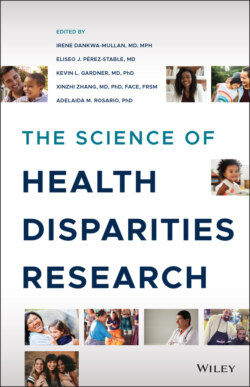Читать книгу The Science of Health Disparities Research - Группа авторов - Страница 69
4.3 Relevant Metrics and Research Methods 4.3.1 Relevant Metrics
ОглавлениеTable 4.1 shows the most common metrics relevant to health disparities in behavioral health determinants and specific examples [9, 25]. Investigations will continue to be undertaken in a wide array of designs and methods, but interdisciplinary teams and approaches, new methodologies, new technology, and multilevel applications of methodologies will take these in new directions.
Table 4.1 Types of disparity measurements and examples from behavioral determinants of health.
Sources: Types of disparity measurements adapted from Appendix 11 of the US Department of Health and Human Services [9]. Data from Example 1 are from the Global Health Data Exchange: US Health Map, and data for Examples 2 and 3 are from Data 2020, a resource linked to Healthy People 2020.
| Indicator | Grouping | Method of comparison | |
|---|---|---|---|
| Measurement of health disparities | |||
| Health outcomes (e.g., life expectancy, mortality, chronic disease rates)Healthcare access/quality of careSocial/environmental/ behavioral risk factors (e.g., neighborhood characteristics, discrimination) | Social grouping by level of disadvantage or advantage (racial/ethnic groups, income groups by poverty level, level of educational attainment) | Comparison of rates on single indicator for two groups (usually top and bottom), absolute difference between rates for two groups, other methods (e.g., slope and relative index of inequality) | |
| Example 1: Disparities in health outcomes | |||
| Life expectancy at birth by US state, both sexes, 2014 | Estimated lowest and highest life expectancy by state, 2014 (years) | Absolute difference | Ratio (Mississippi/Hawaii) |
| Mississippi | Hawaii | (years) | (%) |
| 74.91 | 81.15 | −6.24 | 92.3 |
| Example 2: Disparities in healthcare | |||
| Change in percentage making visit to clinic including tobacco screening, 2009–2011 | Percentage of men and women, 18 years and older, 2009–2011 | Absolute difference | Ratio |
| NH Black | NH White | (Percentage points) | (NH Black/White) |
| −14.8 | −0.1 | −14.7 | 148 |
| Example 3: Disparities in social, environmental, and behavioral risk factors | |||
| Children, 3–11 years of age, exposed to secondhand smoke | Percentage exposed by family poverty status | Absolute difference | Ratio |
| <100% poverty threshold | ≥500% poverty threshold | (Percentage points) | (<100%/≥500%) |
| 62.1 | 14.1 | 48.0 | 4.4 |
Abbreviation: NH, non‐Hispanic.
Certain characteristics have long had a place in quantitative research on behavioral determinants of health and health disparities, including, for example, race or ethnicity, gender, education, and socioeconomic position. Place of residence can be an indicator of socioeconomic position, or it may reveal disparities resulting from a remote, rural location, such as identification as a medically underserved area or one without public transportation, broadband service, or other amenities common in cities. All these characteristics contribute to limited access to and utilization of healthcare or health information.
Place‐based approaches to improving population health outcomes have a lengthy history and are gaining momentum [10]. Among them are multilevel strategies that may involve working with nonprofit organizations or local, state, or national governments, performing epidemiological surveys, evaluating physical environments and nutrition status, and even instituting sustainable brick and mortar clinical care [10].
Inequalities of health, as we too well know, lie not only between countries but within them. One of the most pervasive of these is the common finding that the lower the socioeconomic position of a group, the poorer their health. One of the opportunities that lie before us is the chance to explicate the intricate biological and nonbiological mechanisms driving behavior and thereby understand them more comprehensively within social, cultural, and environmental contexts. Some think of this approach as a scientific one and an opportunity to reimagine old paradigms and models and seek how they may align or not with new theories, models, and measures [26].
